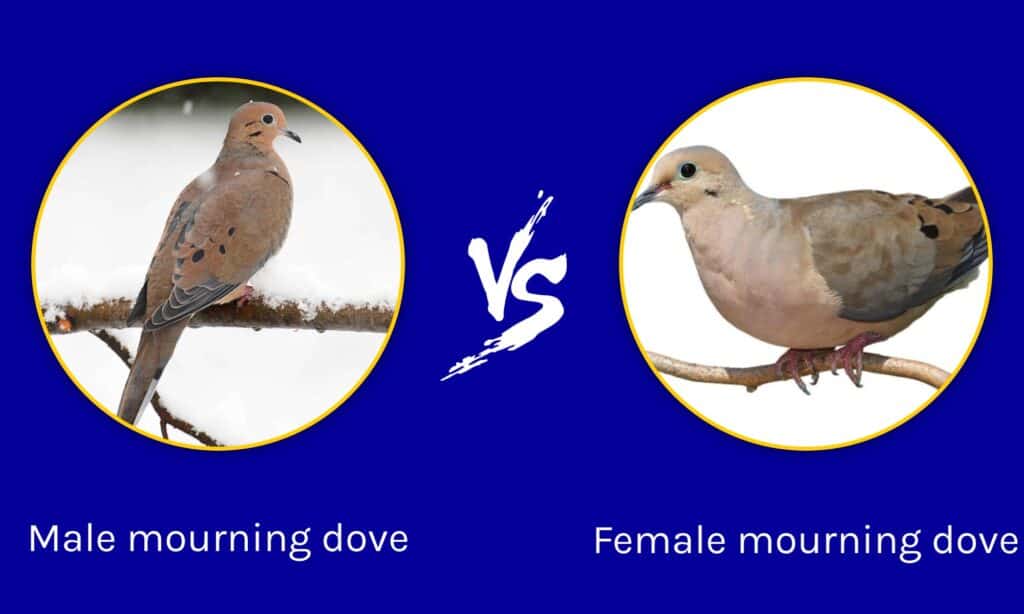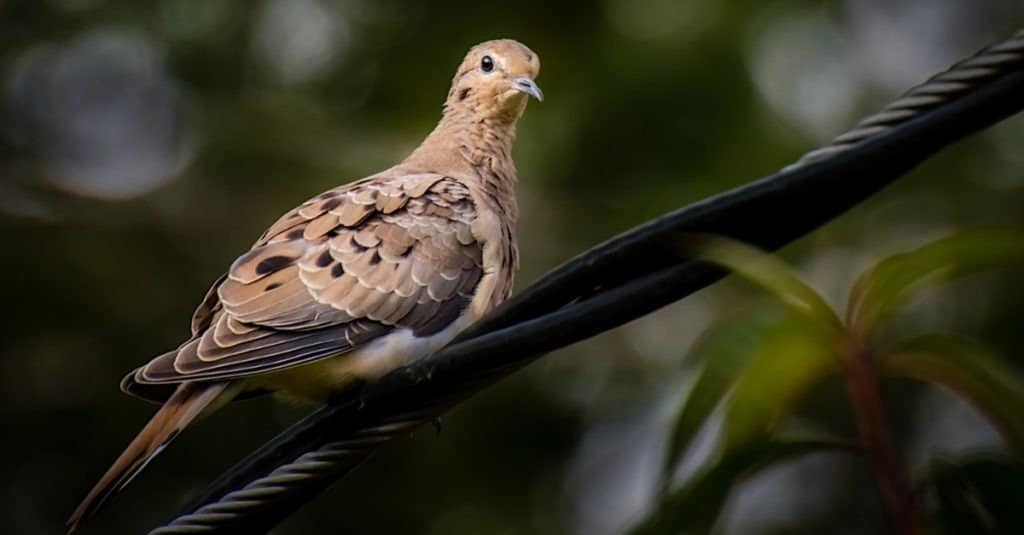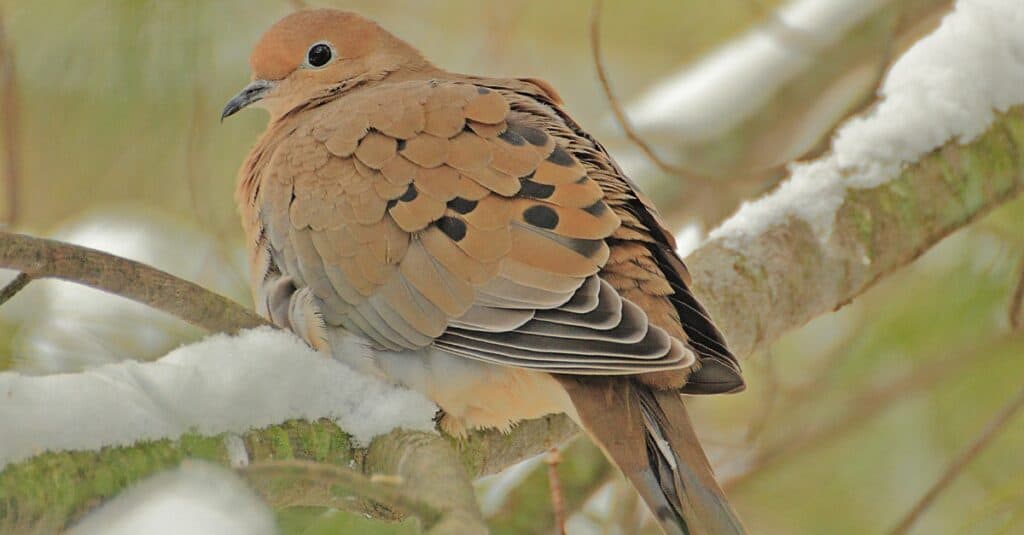If you have ever seen a mourning dove, you’d agree that the bird is beautiful and adorable. However, distinguishing a male and female mourning dove can sometimes be challenging for onlookers as it can be confusing too.
In this article, we will clarify the differences between the two sexes.
Comparing a Male Mourning Dove and a Female Mourning Dove

| Male Mourning Dove | Female Mourning Dove | |
|---|---|---|
| Family | Columbidae | Columbidae |
| Size | Length: 8.9 -14.2 inches Weight: 0.28 – 0.38 pounds Wingspan: 14.6 – 17.7 inches | Length: 8.9 – 14.2 inches Weight: 0.28 – 0.38 pounds Wingspan: 14.6- 17.7 inches |
| Morphology | Bigger with more vivid colors | Rounder head with more tan coloration. |
| Social Behavior | Mostly overdramatic | Quieter compared to the male |
| Diet | Herbivore | Herbivore |
| Predators | Raccoons, hawks, owls, squirrels, snakes. | Hawks, raccoons, owls, squirrels, snakes. |
Key Differences Between a Male and a Female Mourning Dove
The male and female mourning dove belong to the Columbidae family, which houses over 300 species of doves and pigeons. It’s important to note that while the male and female mourning dove may look similar, they are different in a number of ways – color, social behavior, etc.
Male vs. Female Mourning Dove: Size

Male mourning doves are always a tad bigger than females, who usually have a smaller frame compared to them.
©Jay Gao/Shutterstock.com
Although the male and female mourning doves look similar in size, there is a slight difference. The males are always a tad bigger than the females, who usually have a smaller frame compared to the male. While this may not count as a major difference, it could help you identify the birds at close range.
Male vs. Female Mourning Dove: Morphology
The morphology of the male and female mourning dove is similar, seeing that they are the same species. They are both small graceful birds with small heads, a beak, and a body, but their slight differences distinguish them. The female mourning dove has a rounder head compared to the male. The male also has a more intense and vivid coloration than the female.
The male mourning dove has a peculiar bluish-gray crown, light pink breast area, and bright purple-pink patches on the sides of the neck. On the other hand, the female has some of these colors muted as she looks tanner and with a dusty rose color around her head and neck region. Moreover, there are black spots on the feathers of the female mourning dove that are surprisingly absent on the male.
Male vs. Female Mourning Dove: Habitat
These birds share the same habitat as would be expected for birds of the same species. They are native to North America and can be found in southern Canada, the southwestern US, the Greater Antilles, the Atlantic archipelago of Bermuda, south-central Mexico, and Panama. As is popular with the birds in this family, the mourning doves can live almost anywhere except in dense forests. You can find them nesting in many places like trees, shrubs, flower pots, or even in a hole in your roof.
Male vs. Female Mourning Dove: Social Behavior

Female mourning doves are quieter compared to male mourning doves.
©Bonnie Taylor Barry/Shutterstock.com
Paying attention to the social behavior of the mourning doves could help you pick up the difference between the sexes. Like every species, there are points of similarities in the social behavior of both sexes. Mourning doves are social birds that gather together, particularly during mating season. These birds choose a mate and stay that way all through their lifetime. Both birds are responsible for building the nest and raising their young. However, when you observe their behavior closely, you can tell the male apart from the female. The male mourning dove seems to be the more dramatic of the sexes as its activities, particularly during the mating season, distinguishes it from its female counterpart.
The male mourning dove is known to be the one who makes the cooOOO-wooo-wooo-wooo sound that has been associated with the species. They make this sound during the mating season to attract female mourning doves. The female doesn’t carry out much activity when it comes to courtship. She sits and watches the overly dramatic display of the male counterpart, which includes flying around in the air noisily and gliding with fully spread-out wings. When they are done with this elaborate display, they touch back down, bow before the female, and sing their cooing song.
Apparently, at the end of it all, the female mourning dove decides if she is pleased with the presenter or his presentation. This decision is really important as it would determine if the male in question is to be considered a worthy mate or not.
Male vs. Female Mourning Dove: Nest Building
Interestingly, nest building is done by both sexes in a perfect division of labor, where the male gathers the materials for the nest, the female builds the nest using the materials. It is noteworthy that the female mourning dove chooses the site where the nest is to be made.
Male vs. Female Mourning Dove: Diet

Mourning doves eat seeds, berries, and grass.
©iStock.com/gregvandeleest
The basic diet of male and female mourning doves includes seeds, berries, and grass. These birds are herbivores in the wild and depend on warm weather to provide them with their food, and this is the primary reason they are migratory birds, as they have to move away to find warm places where they can get their food during the winter.
Male vs. Female Mourning Dove: Predators
The mourning dove serves as prey to predators like raccoons, hawks, owls, squirrels, snakes, cats, and dogs.
Why is a Mourning Dove Hanging Around My House?
Doves are naturally drawn to areas that provide both food sources and secure nesting sites, making their presence often indicative of a tranquil and welcoming environment.
Landscaping choices also significantly influence the degree of how many sets of doves call your property home, encouraging these birds to visit. Doves play a vital role in the ecosystem as well, contributing to seed dispersal, which aids in the growth and renewal of various plant species.
Doves can provide valuable assistance in your yard by tidying up the area beneath seed feeders or by consuming weed seeds.
Additionally, many dove species are year-round residents, ensuring their consistent presence in your yard across all seasons, even when other birds have migrated elsewhere.
The photo featured at the top of this post is © Tom Cantaffa/Shutterstock.com
Thank you for reading! Have some feedback for us? Contact the AZ Animals editorial team.






